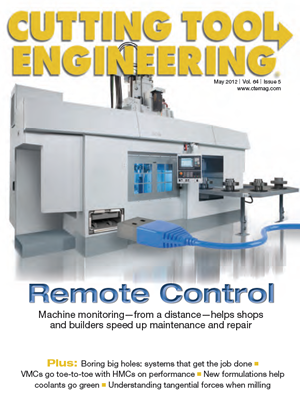A linear motor offers numerous mechanical advantages for a machine tool compared to a ballscrew drive, according to Greg Langenhorst, technical marketing manager for MC Machinery Systems Inc., which supplies Mitsubishi EDMs, lasers and other products. Those advantages include the elimination of backlash, lubrication requirements, pitch-error compensation and wear because a linear motor is a noncontact device.
Linear drive systems are well-established in machine tool design, but Langenhorst said Mitsubishi is the first to incorporate a linear shaft motor, rather than a linear synchronous motor with a flat-plate design, in wire EDMs. The flat-plate design, which has permanent magnets on one side and a set of copper-wrapped iron cores on the other, limits the effective magnetic flux to only half of its potential, the company reports. In contrast, the new cylindrical drive technology’s round shaft uses 360° of magnetic flux. That’s possible because round magnets are packed end-to-end in a stainless steel tube, which is surrounded by coreless copper wire housed in a “forcer.”

Courtesy of MC Machinery Systems
MC Machinery Systems’ cylindrical drive technology replaces ballscrews with linear shaft motors (above) in Mitsubishi wire EDMs, such as the MV1200R (below).

This enables the air gap between the magnets and copper wire to be significantly larger in the circular style than the flat design, Langenhorst noted. “The air gap is not as critical because we’re using the magnetic flux from all the way around those permanent magnets,” he said.
He added that because the gap distance isn’t so critical, the alignment of the forcer isn’t critical. “If the forcer is a little closer on one end of the shaft than the other, it doesn’t hurt,” Langenhorst said. “It’s much more forgiving in that respect.”
The cylindrical style also doesn’t experience cogging, a resistance to movement followed by an attraction to movement, he explained. Therefore, if a shaft is set up on linear ways without any power being supplied, the shaft will effortlessly glide from one end to the other when manually pushed. “Cogging is inherent in a flat-plate drive system,” Langenhorst said. “When you push the core assembly along a magnetic plate, it’s going to be very jerky.”
The cylindrical drive technology also reduces power consumption by up to 40 percent and provides highly accurate “nanolevel incrementation,” according to Langenhorst.
“The beautiful part of this thing is it fits in the same space as a ballscrew,” he said, adding that redesigning the machine only required changing the motor mount. “The shaft basically replaces the ballscrew and the forcer replaces the nut.”
The cylindrical drive technology is standard on Mitsubishi’s MV series wire EDMs.
For more information, contact MC Machinery Systems Inc., Wood Dale, Ill., at (630) 616-4068 or www.mitsubi shi-world.com.
Related Glossary Terms
- backlash
backlash
Reaction in dynamic motion systems where potential energy that was created while the object was in motion is released when the object stops. Release of this potential energy or inertia causes the device to quickly snap backward relative to the last direction of motion. Backlash can cause a system’s final resting position to be different from what was intended and from where the control system intended to stop the device.
- flat ( screw flat)
flat ( screw flat)
Flat surface machined into the shank of a cutting tool for enhanced holding of the tool.
- linear motor
linear motor
Functionally the same as a rotary motor in a machine tool, a linear motor can be thought of as a standard permanent-magnet, rotary-style motor slit axially to the center and then peeled back and laid flat. The major advantage of using a linear motor to drive the axis motion is that it eliminates the inefficiency and mechanical variance caused by the ballscrew assembly system used in most CNC machines.


